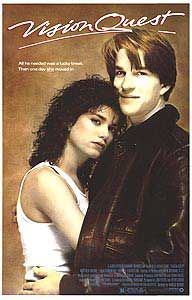I watched Vision Quest, and it was awesome

I’m a sucker for martial arts flicks from the 80s, whether it be from Japan or Hong Kong, or from the US. Even if it’s rubbish, I’ll probably still enjoy it, because bad 80s movies are entertaining by default. Vision Quest is hardly earth-shattering, but it’s not a stinking pile of gloop either. In fact, it did a very good job of entertaining Wifey and I for a couple of hours. This is because Wifey is suitably tragic as well. That’s yet another sign of our collective awesomeness.
Moving along – Vision Quest’s a bit of an unusual pick as it revolves around wrestling competitions from the perspective of a US high school, rather than my usual martial arts pics featuring one-man armies with optional mullets. While the film began with a bit of a false start, it didn’t take long to win me over. First of all, it’s a teen movie with 80s grit. Love it. It also features Jake Ryan (well, Michael Schoeffling, but he’ll always by Jake Ryan to anyone whose a fan of 80s John Hughes gold), so there’s more thumbs up, particularly if you’re like Wifey and still harbour a secret passion for Jake Ryan… bugger knows why she married a ranga with one leg considering it’s a bit of an antithesis to 80s Schoeffling, though I’m certainly not complaining 😉
Then there’s the Madonna factor. Not only do we get to see her do her quality 80’s dancing, but we get “Crazy For You” played throughout the movie during montages, in a club, as an instrumental during terrible romantic moments, et cetera.
In fact, let’s give this one another thumbs up for cramming in plenty of montages – if there’s anything Trey Parker has taught us using the power of animation or marionettes, it’s that everything works better as a montage.
But going back to Madonna, I think we need to take a moment to consider the soundtrack. As noted, not only is there some 80s Madonna in there (I’ll admit to enjoying 80s Madonna sugarpop), you get a menagerie of awesomeness in the form of Don Henley, Style Council, Foreigner and (wait for it), Journey. Epic.
But what about the actual movie? Wasn’t too bad actually – I don’t know a lot about wrestling, but it was interesting to see some of the groundwork in there. The Wikipedia entry tell me it’s a bit of a cult classic among middle and high school wrestlers, so I’m guessing there’s something in there.
But for me, it was the cast, the music and the setting that won me over. This of course is completely obvious in this blocky trailer on YouTube:
I know I’m tragic, but as GI Joe told me in the 80s, knowing is half the battle.




